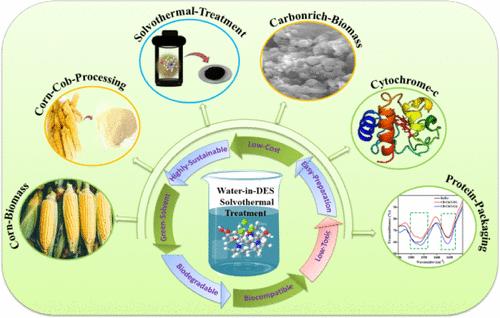当前位置:
X-MOL 学术
›
ACS Sustain. Chem. Eng.
›
论文详情
Our official English website, www.x-mol.net, welcomes your
feedback! (Note: you will need to create a separate account there.)
Ecofriendly and Conductive Corn-Cob-Based Biomass Driven from Aqueous Deep Eutectic Solvents: A Suitable Media for Enzyme Structure, Storage, and Activity at High Temperature
ACS Sustainable Chemistry & Engineering ( IF 7.1 ) Pub Date : 2024-11-05 , DOI: 10.1021/acssuschemeng.4c06294 Niketa Yadav, Deepak Chahar, Meena Bisht, Pannuru Venkatesu
ACS Sustainable Chemistry & Engineering ( IF 7.1 ) Pub Date : 2024-11-05 , DOI: 10.1021/acssuschemeng.4c06294 Niketa Yadav, Deepak Chahar, Meena Bisht, Pannuru Venkatesu

|
Production of biomaterials from lignocellulosic biomass waste is of prime importance for diverse applications. However, the use of harsh chemicals, extreme conditions, and tedious processes to convert it into useful materials are the major bottlenecks for its application. Herein, leftover waste of corn-cob biomass (CB) was converted into functional carbonaceous material via a solvothermal process using water in deep eutectic solvents (DESs) by employing two DESs namely, choline chloride-glycerol (ChCl-Gly) and ChCl-ethylene glycol (ChCl-EG). The synthesized CB-based solvothermal carbon materials, using CB-ChCl-Gly and CB-ChCl-EG, were characterized to verify incorporated morphological variations. The obtained results showed that the synthesized carbon materials were rich in oxygen functionality with a more porous, globular surface structure. Further, the detailed analysis of the feasibility of the synthesized biomaterials as biocompatible carriers for cytochrome-c (Cyt-c) was evaluated. The peroxidase-like activity was remarkably enhanced up to 1.5-fold compared to the native enzyme. Further, the biocompatibility of these synthesized carbon materials was validated using the Michaelis–Menten equation. Besides this, time- and temperature-dependent studies of Cyt-c after immobilization of these biomass-based carbon materials demonstrated preservation of structural integrity as well as improved enzymatic activity. Various biophysical techniques validated the improved secondary and tertiary structures of the enzymes after immobilization. The micrograph obtained using transmission electron microscopy (TEM) microscopy and hydrodynamic size (dH) and zeta potential values measured using dynamic light scattering (DLS) showed successful protein immobilization on the synthesized carbon materials. Interestingly, the secondary structure of Cyt-c is maintained at higher temperatures in the presence of both CB-ChCl-EG and CB-ChCl-Gly carbon materials. Overall, this study elucidates a sustainable source and ecofriendly method of preparation of solvothermal carbon material and displays its beneficial influence on the activity and stability of Cyt-c. Remarkably, proving to be a protein-friendly host, CB will be helpful for long-term protein packing, which may provide a foundation for imaging modalities for the biomolecules with diverse industrial applications.
中文翻译:

由水性共熔溶剂驱动的环保和导电玉米芯基生物质:一种适用于高温下酶结构、储存和活性的介质
利用木质纤维素生物质废弃物生产生物材料对于各种应用至关重要。然而,使用刺激性化学品、极端条件和繁琐的过程将其转化为有用的材料是其应用的主要瓶颈。在此,玉米芯生物质 (CB) 的剩余废物通过使用水在深共熔溶剂 (DES) 中的溶剂热工艺转化为功能性碳质材料,采用两种 DES,即氯化胆碱-甘油 (ChCl-Gly) 和 ChCl-乙二醇 (ChCl-EG)。使用 CB-ChCl-Gly 和 CB-ChCl-EG 对合成的 CB 基溶剂热碳材料进行了表征,以验证掺入的形态变化。所得结果表明,合成的碳材料具有丰富的氧官能团,具有更多的多孔球状表面结构。此外,还评估了合成的生物材料作为细胞色素-c (Cyt-c) 生物相容性载体的可行性的详细分析。与天然酶相比,过氧化物酶样活性显著提高了 1.5 倍。此外,这些合成碳材料的生物相容性使用 Michaelis-Menten 方程进行了验证。除此之外,固定这些基于生物质的碳材料后 Cyt-c 的时间和温度依赖性研究表明,结构完整性得以保持,酶活性也有所提高。各种生物物理技术验证了固定后酶的二级和三级结构的改善。 使用透射电子显微镜 (TEM) 显微镜获得的显微照片以及使用动态光散射 (DLS) 测量的流体动力学尺寸(dH) 和 zeta 电位值显示蛋白质成功固定在合成的碳材料上。有趣的是,在 CB-ChCl-EG 和 CB-ChCl-Gly 碳材料存在下,Cyt-c 的二级结构在较高温度下保持。总体而言,本研究阐明了制备溶剂热碳材料的可持续来源和环保方法,并显示了其对 Cyt-c 活性和稳定性的有益影响。值得注意的是,CB 被证明是一种蛋白质友好型宿主,将有助于长期蛋白质包装,这可能为具有不同工业应用的生物分子的成像模式提供基础。
更新日期:2024-11-05
中文翻译:

由水性共熔溶剂驱动的环保和导电玉米芯基生物质:一种适用于高温下酶结构、储存和活性的介质
利用木质纤维素生物质废弃物生产生物材料对于各种应用至关重要。然而,使用刺激性化学品、极端条件和繁琐的过程将其转化为有用的材料是其应用的主要瓶颈。在此,玉米芯生物质 (CB) 的剩余废物通过使用水在深共熔溶剂 (DES) 中的溶剂热工艺转化为功能性碳质材料,采用两种 DES,即氯化胆碱-甘油 (ChCl-Gly) 和 ChCl-乙二醇 (ChCl-EG)。使用 CB-ChCl-Gly 和 CB-ChCl-EG 对合成的 CB 基溶剂热碳材料进行了表征,以验证掺入的形态变化。所得结果表明,合成的碳材料具有丰富的氧官能团,具有更多的多孔球状表面结构。此外,还评估了合成的生物材料作为细胞色素-c (Cyt-c) 生物相容性载体的可行性的详细分析。与天然酶相比,过氧化物酶样活性显著提高了 1.5 倍。此外,这些合成碳材料的生物相容性使用 Michaelis-Menten 方程进行了验证。除此之外,固定这些基于生物质的碳材料后 Cyt-c 的时间和温度依赖性研究表明,结构完整性得以保持,酶活性也有所提高。各种生物物理技术验证了固定后酶的二级和三级结构的改善。 使用透射电子显微镜 (TEM) 显微镜获得的显微照片以及使用动态光散射 (DLS) 测量的流体动力学尺寸(dH) 和 zeta 电位值显示蛋白质成功固定在合成的碳材料上。有趣的是,在 CB-ChCl-EG 和 CB-ChCl-Gly 碳材料存在下,Cyt-c 的二级结构在较高温度下保持。总体而言,本研究阐明了制备溶剂热碳材料的可持续来源和环保方法,并显示了其对 Cyt-c 活性和稳定性的有益影响。值得注意的是,CB 被证明是一种蛋白质友好型宿主,将有助于长期蛋白质包装,这可能为具有不同工业应用的生物分子的成像模式提供基础。


















































 京公网安备 11010802027423号
京公网安备 11010802027423号